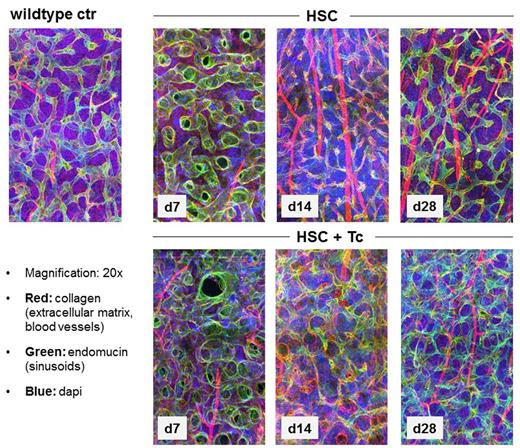Abstract
Allogeneic hematopoietic cell transplantation (allo-HCT) represents the most powerful form of cellular therapy comprising chemo- and/or radiotherapy-based host conditioning and infusion of donor grafts. Grafts contain hematopoietic stem cells (HSC), progenitors, and mature immune cells. Particularly donor T cells (Tc) are critical for disease control and long-term cure, but are also responsible for graft-vs-host-disease (GVHD), in which donor Tc target and destroy host tissues. Regarding the recovery of hematopoietic and immune function following allo-HCT donor Tc are believed to be beneficial. Our prior data have been conflicting with this presumption because little attention has been paid to subclinical effects of alloreactive Tc on the bone marrow (BM) and how structural damage of its microenvironment affects hematopoiesis.
Here, we studied in an MHC-matched, minor antigen mismatched HCT model (C3H-SW > C57BL/6 (B6), both H2b) the effects of lethal total body irradiation (TBI) followed by infusion of purified HSC (cKIT+Sca1+Lin-) alone or in combination with Tc on the hematopoietic and non-hematopoietic BM compartments. At 1, 2, 3, and 4 weeks (w) post-HCT bones and marrow were analyzed by FACS and 3D-confocal microscopy imaging. Marrow was flushed from long bones for FACS analysis of the hematopoietic content. Bones were digested with collagenase for FACS analysis of the non-hematopoietic compartment. Femurs or sternums were used for 3D imaging.
Post allo-HCT there was a transient weight loss in both groups (HSC and HSC+Tc), but no specific signs of overt GVHD. Total BM cell counts dropped, but began to recover by w2 post-HCT. At 2w mice given HSC had significantly higher absolute BM counts compared with HSC+Tc recipients. Absolute Tc numbers in the BM were higher in HSC+Tc recipients (vs HSC alone). In contrast, B-cells (B220+) recovery occurred promptly in HSC recipients but was severely impaired in the HSC+Tc group with significantly lower B-cell counts at 2, 3, and 4w post-HCT (p<0.0001) in the latter. Likewise, BM granulocyte (CD11b+Gr1+) recovery at 2, 3, and 4w was significantly better in HSC vs. HSC+Tc recipients. Regarding the non-hematopoietic compartment CD45-Ter119-CD31+ endothelial cells (EC) were significantly reduced in both groups compared with wildtype controls (WT) at 1, 2, and 3w post-HCT but recovery was superior in the HSC vs the HSC+Tc group with significantly higher EC counts at 2 and 3w. The most pronounced effects were observed for CXCL12-abundant reticular (CAR) cells (CD45-Ter119-CD31-CD140B+), which - compared with WT controls - were reduced in HSC recipients at 1, 2, and 3w, but normalized at 4w post-HCT. In HSC+Tc recipients CAR cells were significantly lower than in the HSC group and remained reduced at w4. 3D-confocal microscopy imaging confirmed these observations and revealed rapid recovery of the extracellular matrix and vascular structures, with simultaneous disappearance of adipocytes at 2w post-HCT in mice given pure HSC. In contrast, in recipients of HSC+Tc severe disruption of the structural integrity with no signs of recovery of the vascular structures (Figure) but rather occupation of space by adipocytes was observed at this time. Control experiments transplanting B6.45.1 HSC +/- Tc into congenic B6.45.2 mice revealed that the effects observed were due to alloreactivity, as in congenic transplant settings regeneration of the hematopoietic and non-hematopoietic populations occurred promptly and was similar in both groups as assessed by FACS and 3D microscopy.
In clinical HCT delayed hematopoietic reconstitution presents a major problem contributing to increased morbidity and mortality. Multifactorial influences impairing hematopoiesis have been identified including viral infections, drugs, and graft type, while little attention has been paid to the effects of alloreactive Tc on the BM and how disruption of this complex microsystem affects hematopoietic function. Our data show that alloreactivity has a major impact on the non-hematopoietic stromal and vascular compartment of the BM in terms of both damage and reconstitution of the microarchitecture and ultimately hematopoietic recovery. Whether alloreactive Tc directly damage endothelium, stroma and other cell types or alternatively act via an inflammatory cytokine/chemokine milieu needs to be elucidated.
No relevant conflicts of interest to declare.
Author notes
Asterisk with author names denotes non-ASH members.


This feature is available to Subscribers Only
Sign In or Create an Account Close Modal